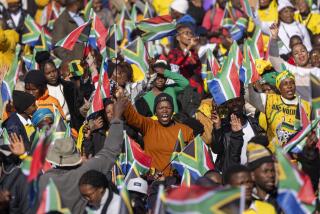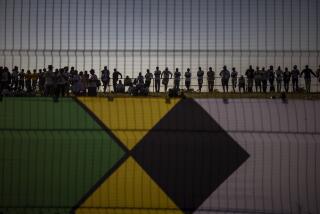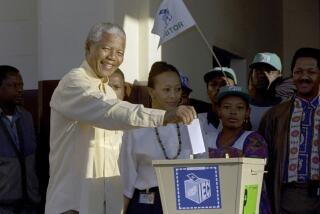South Africa: Vigilantesâ New Violence : Terror Gangs in Townships
JOHANNESBURG, SOUTH AFRICA â South Africaâs state of emergency ended officially three weeks ago but the terror in some black townships and in homeland areas is escalating--so is the death toll.
The partial withdrawal of security forces has led to an increase in the sinister activities of shadowy gangs of âvigilantes.â They are mostly local, uncoordinated, but they do have a common aim: breaking the hold of left-wing radicals in the townships.
The left has its own terror gangs--youths who hold kangaroo courts and hack to death or burn suspected âcollaboratorsâ--though they represent only a fraction of the young radicals in the former emergency areas; a majority of the others play a positive role in their communities.
The right-wing vigilantes, mostly older men, are equally brutal and have even less excuse for mindless killing. Many are in the pay of black councilors or homeland officials.
There have been recent isolated cases of white vigilantes. In Krugersdorp, an industrial town west of Johannesburg, three Afrikaners await trial on a charge of burning a black man to death; they are believed to be the first whites accused of this horrific manner of murder.
Other whites in Krugersdorp have been arrested, accused of taking potshots at blacks from moving cars. The town is a stronghold of the Afrikaner resistance movement, with its own organized nighttime security patrols. But the movementâs leader, Eugene Terre Blanche, denies that his members have any connection with the killing or attacks on blacks, claiming they have appalled him.
A human-rights lawyer, Nicholas Haysom, who wrote âMabangalalaâ a new book creating considerable controversy in South African political circles, makes the startling allegation that local officials, and in some cases police, are actively or passively supporting right-wing black vigilantes, leaving them free to operate against their enemies. The police have flatly rejected the charge.
Last year Haysom was a member of the late Molly Blackburnâs team investigating the police shooting in Uitenhage and the mysterious disappearance of United Democratic Front officials in the Eastern Cape. Now he is warning in his book that unless the vigilantes are curbed, the level of brutality will escalate dramatically; that warning seems already to be coming true.
âMabangalala,â subtitled âThe Rise of Right-Wing Vigilantes in South Africa,â describes a clear pattern of support for the âfascistsâ by local authorities in black areas, allowing the vigilantes to use township council facilities.
Despite the police denial, Haysom claims that black vigilantes âbelieve they have police support.â They strike against anti-apartheid leaders and aim to neutralize âvictoriesâ by community leaders in black townships. âWhen leaders are systematically assaulted or killed and the police appear unwilling to curb the activities of the vigilantes,â writes Haysom, âit is obvious that no popular organization can continue to function openly. In such cases it is not only vigilante interests that are served but also those of official agencies that the popular organization has challengedâ.
Haysom believes that in black homelands such as Kwandebele, where vigilantes were blamed for killing 19 people at Moutse in January, the violence had tacit approval from âthe formal political structures.â
In Natab, which has seen âsome of the most savage mob action in South Africa,â many incidents have been attributed to warriors linked with Inkatha--the cultural organization formed by the Kwazulu leader, Chief Mangosuthu Gatsha Buthelezi. This allegation has been denied by Inkathaâs secretary general, Dr. Oscar Dhlomo, who says it has repeatedly denounced black-on-black violence.
âMabangalalaâ carries gruesome pictures of men--and some women--bearing marks of savage sjambok (hide) whippings allegedly inflicted by vigilantes.
Black vigilante groups are now believed to be behind the unsolved murders and disappearances of UDF officials in the Eastern Cape last year. Four Cradock officials--including Matthew Goniwe, the townâs popular education leader--were found dead, their bodies mutilated, after being missing for three weeks. Another three UDF leaders from Port Elizabeth disappeared while driving to the airport; they are still missing 10 months later.
Chief Ampie Mayisa, of Leandra in Eastern Transvaal, was killed before a scheduled meeting with Chester A. Crocker, U.S. assistant secretary of state for African affairs. Mayisa is also believed to have been a vigilante victim. Community leaders claim the chief had asked, unsuccessfully, for police protection.
Despite government denials, suspicion that police and black councils do nothing to stop vigilante terror grows daily.
Last week, 29 people were killed in two days, including 11 in the Bophuthatswana homeland. This is more than double the daily death rate at the height of the emergency. Blacks are asking what the emergency achieved and why the government seems complacent about renewed violence.
Government leaders dismiss criticism of police action by repeating that they are merely carrying out their duty to maintain law and order. But a year after Uitenhage, and 26 years after Sharpeville, security forces are still often unable to restrain rioters without using live ammunition.
The government must now find ways of stopping the violent deaths in black townships, whether from police fire or black lawlessness; otherwise, South Africaâs international stock will sink even further.
More to Read
Sign up for Essential California
The most important California stories and recommendations in your inbox every morning.
You may occasionally receive promotional content from the Los Angeles Times.










